Centipedes. Millipedes. What’s the difference? And why should I care? While the centipede and millipede look quite similar (and are often confused for one another) they are far from the same insect. Among the visual characteristics and differences, centipedes and millipedes also differ in their behavior and threat to humans. As a homeowner, it is important to know the difference and understand how best to handle each insect within your home.
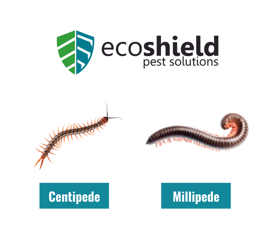
What is a centipede?
Centipedes are a predatory arthropod of the Myriapoda subphylum, a group of arthropods that also contain millipedes and other many-legged insects. Centipedes are long, segmented insects with one pair of legs per body segment. Despite their name, centipedes don’t have 100 legs, but rather a varying amount between 30 and 382. Interestingly, centipedes always have an odd number of legs, so no centipede in the world actually has exactly 100 legs!
These strange-looking insects may strike fear in onlookers - and it may be best to follow your instincts and keep your distance. All centipedes are venomous and use their forcipules (pincer-like appendages) to inject venom along with a painful bite. While the venom is generally not considered to be a risk to humans, the centipede’s bite alone is reason enough to avoid handling them directly.
Centipedes can range greatly in size, the smallest of which maxing out at just a few millimeters, while the largest can reach up to a foot long! It’s estimated that there are approximately 8,000 different centipede species worldwide living in a wide variety of environments. Most centipedes native to the United States are yellowish or dark brown in color, though some in subterranean climates can be quite vibrant.
Luckily, the most commonly encountered centipede here in the US is the Scutigera coleoptrata, otherwise known as the house centipede. These centipedes are small, 1 to 1.5 inch long insects with 15 pairs of legs and a yellowish-gray body. The antennae of the house centipede are actually longer than their entire body, as are the centipede’s last pair of legs.
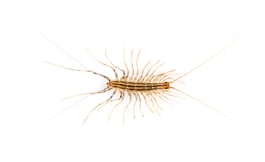 House Centipede
House Centipede
What are millipedes?
Millipedes, like centipedes, are arthropods of the Myriapoda subphylum, but part of a class known as Diplopoda. Most millipedes have very long cylindrical or flattened bodies with more than 20 segments. Each segment has two pairs of jointed legs that allow them to move slowly but smoothly across surfaces. Although the millipede’s name suggests it has 1,000 feet, no species was known to actually have this many legs until the discovery of the Eumillipes persephone, which can actually have up to 1,300 feet!
The vast majority of millipedes eat decaying leaves and other plant matter (detritivores). Some may drink fluids within plants or feast on fungi, and a very small minority of millipedes are predatory. Millipedes are harmless to humans physically, but they can pose a threat to our gardens and crops. Especially in greenhouse environments, millipedes are known to cause significant damage to emergent seedlings and other fragile plant growth.
Millipedes are considered to be some of the oldest known land animals - some of their prehistoric ancestors grew to be over 6 feet long! Today, the largest millipede species max out at around 15 inches, but most commonly encountered millipedes are much, much smaller. Most millipedes are black, brown, or reddish in color, and one species native to California actually glows in the dark. Like centipedes, millipedes live in a variety of diverse environments and live in every US state, including Alaska and Hawaii.
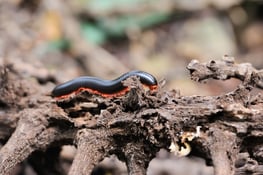 Millipede
Millipede
What are some key differences between centipedes and millipedes?
A major difference that most homeowners seek clarity on is the danger of centipedes and millipedes - centipedes are venomous and known to deliver some seriously painful bites, while millipedes do not typically bite or sting and are not venomous. Centipedes will bite when they perceive a threat, whereas millipedes will curl up into a tight ball when in danger. If you were to touch a millipede or try to pick it up, it would likely curl up in a spiral and essentially play “dead.” The same cannot be said for a centipede, who may bite or “sting” you with its many pointed legs if disturbed.
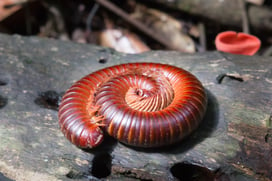 Millipede curled up
Millipede curled up
Visually, it may be difficult to differentiate the two long, segmented insects. There are a few ways to tell them apart, however. Millipedes tend to be longer, smoother, and have considerably more legs than a centipede. When observing from the side, millipedes will appear more rounded and cylindrical in shape, whereas a centipede will look flatter. These differences in characteristics separate the two similar insects by class - centipedes belonging to the class of Chilopoda, and millipedes belonging to the class of Diplopoda.
Another difference is in their speed. Centipedes are known for their ability to move surprisingly fast, zipping across surfaces quickly. Millipedes, on the other hand, tend to move far more slowly. In comparison, millipedes move at a meandering pace, seemingly in no hurry. Millipedes also burrow, while centipedes do not.
These insects also differ greatly in diet. Centipedes, as mentioned previously, are carnivorous predators that “hunt” and kill prey. They do this by injecting their prey with venom found in their forcipules, or pinchers. Millipedes are primarily detritivores, feeding on decaying organic matter or roots of seedlings. Millipedes are ecologically significant as facilitators of microbial decomposition and aiding in soil nutrient cycles and turnover.
Do centipedes and millipedes come indoors?
While both centipedes and millipedes are primarily outdoor insects, they do occasionally make their way indoors either accidentally or in search of something. Centipedes will sometimes move indoors as the weather cools, seeking protection from the elements and shelter from the cold. They also may be searching for prey in your home - some of their favorite meals consist of common indoor pests such as spiders, silverfish, bed bugs, beetles, and cockroaches. House centipedes in particular find indoor environments especially comfortable and ideal for long-term living. They will frequently overwinter in homes, using a well-heated and safe home as an opportunity to continue their lifecycle and reproduce.

Millipedes are a less common sight in homes as they prefer very moist and wet environments. They will occasionally make their way indoors if their outdoor environment becomes too hot and dry, or conversely, if their environment becomes too saturated in the event of very heavy rain or flooding. Millipedes generally do not survive long indoors, unless they find a suitably damp and dark environment. Most millipedes who find themselves indoors will die within days or mere hours due to lack of moisture.
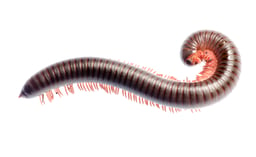
What should I do if I find a centipede or millipede in my home?
While neither centipedes nor millipedes cause damage to homes or belongings, they are often an unwelcome sight in your home. We strongly discourage attempting to remove centipedes in particular on your own due to their known ability to deliver painful bites and stings. That said, there are very few options on the market for safely removing centipedes from your home.
EcoShield offers pest solutions for insects that many other pest control companies don’t provide services for. If you’re experiencing a problem with centipedes or millipedes in your home, don’t hesitate to give us a call today or fill out the form on this page. Centipedes and Millipedes are also covered under the Shield Home Protection Plan. With this plan, if you see centipedes or millipedes in your home, you can give us a call and we'll come out and take care of them quickly.
At EcoShield, your health and safety is our priority. Contact us today to keep your home centipede and millipede free. Our expertly trained professionals will inspect your home and help you identify the best course of action for eliminating your centipede or millipede problem.